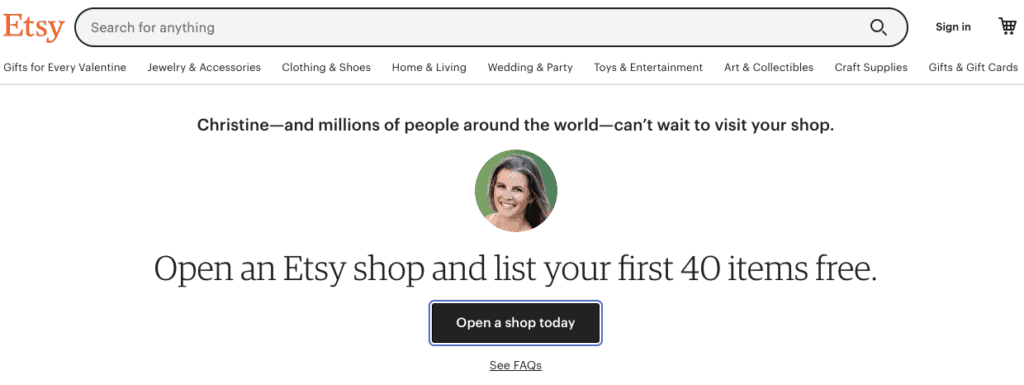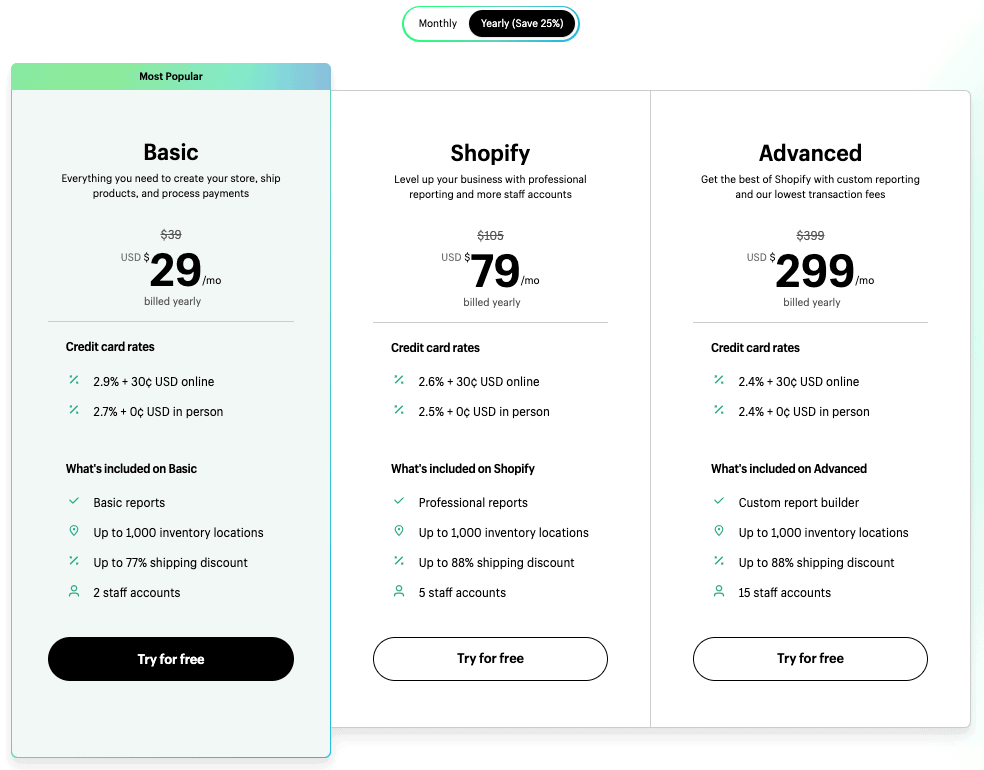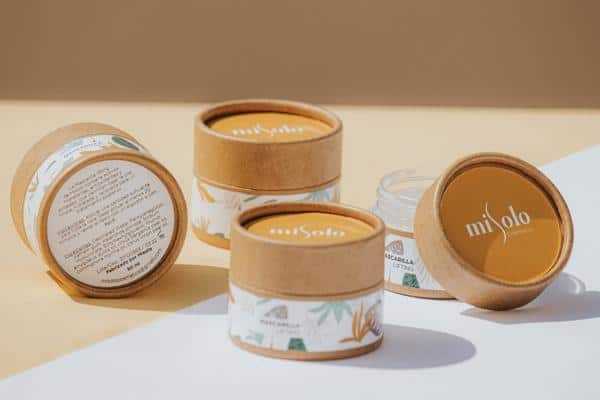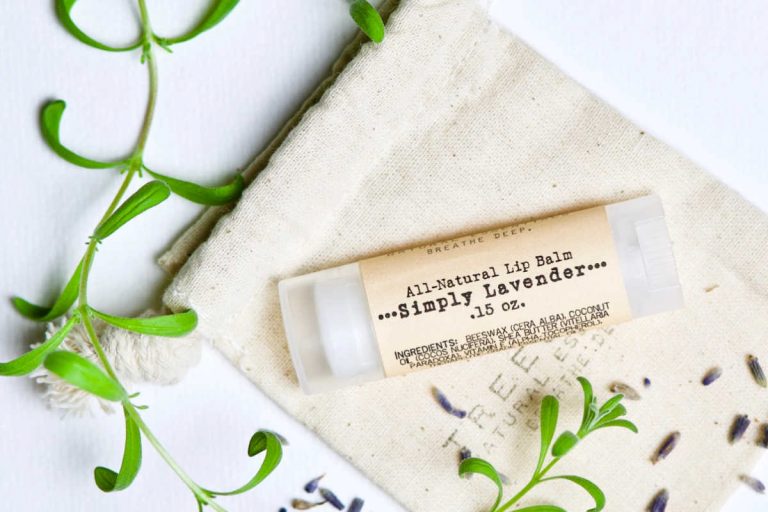I’m willing to bet that you’ve had your eyes peeled for the best possible online platform to run your handmade skincare business since you started dreaming of entrepreneurship.
The fact is, it is really up to YOU and what YOU are bringing to the table, not the other way around.
There are many awesome platforms out there that can bring you to ‘quit your full-time job’ success. The right one depends on your time, skillset, experience, stage in business, and resources.
This post will discuss two of the best online platforms for makers (with insider-only information and screenshots) and which is right for you and your UNIQUE handmade skincare business.

This post may contain affiliate links, meaning I get a commission if you decide to make a purchase through my links (at no cost to you). Please read the disclosure for more information.
The Best Online Platforms to Sell Handmade Skincare Products
As a handmade skincare maker with over a decade of experience, I have hosted my products on several online platforms: Etsy, Wix, SquareSpace, EcoHabitude, Woocommerce, Shopify (not to mention selling via Facebook, Instagram, subscription boxes, and in-person events).
In terms of revenue and ease of use (a winning combo), my top two favorite platforms are Etsy and Shopify.
Platform Type (E-commerce vs. Marketplace)
Shopify: E-commerce platform
Shopify is an e-commerce platform that you build on your own. You are completely independent. A single seller in charge of it all: your own products, services, communications, taxes, etc.
Below is a home page example of a former Shopify site of mine – all of the dropdowns in the header go to my products only.

Etsy: Marketplace
Etsy is a marketplace, which means there is one main website that hosts many sellers – in the case of Etsy, there were 7.52 million active sellers in October 2022 (source).
Etsy does not own your inventory, but it can set its own company rules about your communications with customers, fees, rules to stay active, and the algorithm (who sees your content).
Below is a home page example of a former Etsy site of mine – all of the dropdowns in the header go to different sellers and categories, such as jewelry, toys, and other handmade skincare shops.
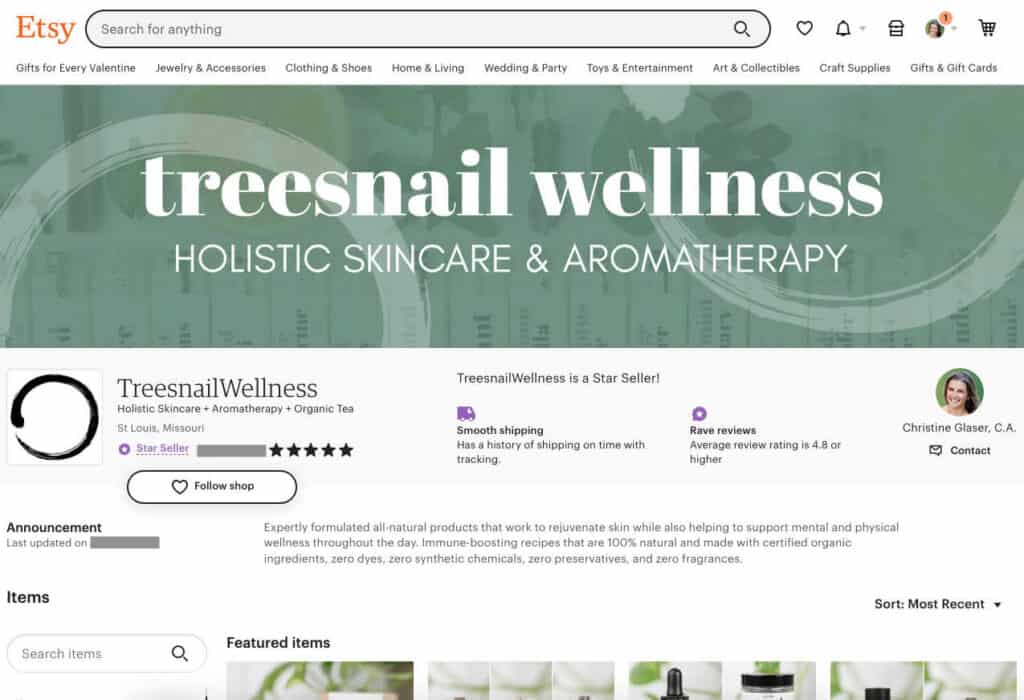
Ownership (Own vs. Rent)
Shopify: You Own
Because you ‘own’ your Shopify site and everything about it is yours, you also own all of the incoming information. Your site reviews, your customers’ information, any email subscribers that were collected, etc.
If you wanted to take all of this information and start another shop or website, you absolutely could.
Etsy: You Rent
Through a marketplace such as Etsy, you are not entitled to any of the incoming information. It is completely against policy to keep your own records of customer contact information (emails, shipping addresses, etc.).
This means that if you want to leave Etsy to start your own stand-alone website like Shopify, you cannot take customer information with you to market to these individuals.
Additionally, as a renter, you can be ‘evicted’ at any time. If you break a rule or Etsy decides to stop carrying your category, your shop can be suspended or removed without warning.
Free Trials
Shopify: 3 days + $1/month for the first 3 months
Shopify recently changed how they let you try their platform and I LOVE their new approach: a free trial for 3 days, and then just $1 a month for 3 months.
This is a fabulous amount of time to see if the platform is right for you – more than enough wiggle room, even if you are building your business on very part-time hours.
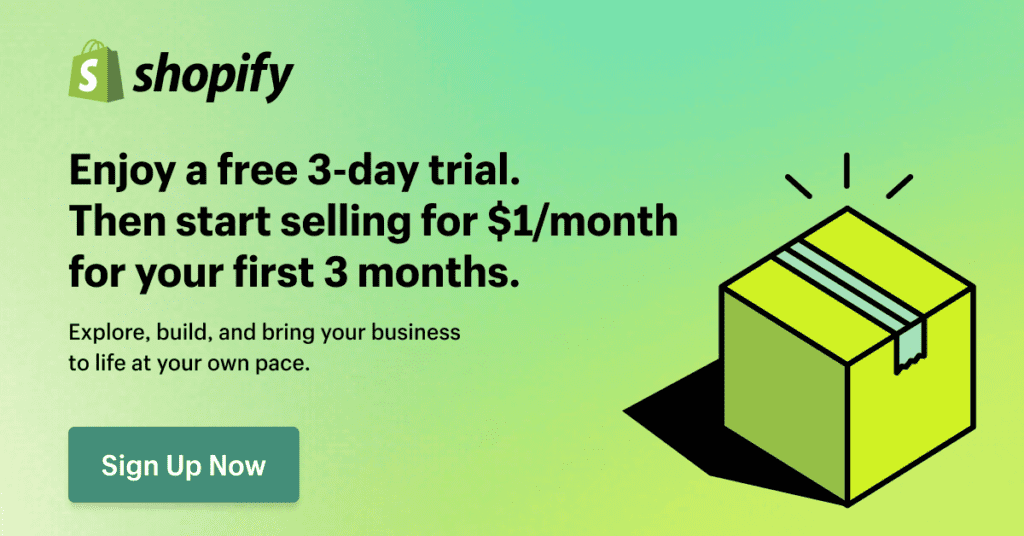
Etsy: No free trials, but very minimal startup costs
Etsy does not have a free trial, but with the minimal cost of only twenty cents per listing, your investment is practically nothing to play around to see if this is the right online platform for your handmade skincare business.
You can even get 40 free listings here if you haven’t opened your shop yet.
Subscription Fees
Shopify: Monthly and Yearly Plans
You can pay for your Shopify subscription on either a monthly or annual basis. Paying for an entire year upfront saves you 25% overall, which is definitely worth it if you know you’ll be sticking to Shopify.
Shopify increased its pricing in January of 2023 for the first time in 12 years – it’s a safe bet they won’t do so again any time soon! However, if you want to check, see Shopify’s most recent pricing here.
Etsy: No Subscription Fees
There are no subscription fees to sell on Etsy Standard (this is the default Etsy platform).
There is another option for a slightly upgraded plan called ‘Etsy Plus’ for $10/month – I won’t be discussing that option in this post, as I do not recommend it for new sellers.
Other Fees
Shopify: Transaction Fees
On top of the monthly (or annual) subscription fee for Shopify, you will also incur a 2.9% + 30 cents transaction fee for online credit card sales.
This transaction fee is typical for all e-commerce platforms.
Etsy: 6 Possible Fees
While the lack of a monthly or annual subscription fee for using Etsy may sound attractive, it is important to understand the other fees Etsy collects.
Listing Fee: Every listing (product) you publish on Etsy has a 20-cent fee. This fee keeps the listing on your shop for 4 months. If you sell your item and want the listing to automatically renew after every sale, you will pay another 20 cents each time it is ‘relisted’.
Transaction Fee: Etsy charges a 6.5% transaction fee for every sale (the price you have it listed for + shipping + gift wrapping)
Conversion Fee: If you make a sale in a currency that is different than that of your payment account, you will incur a 2.5% conversion fee.
Etsy Ad Fees: If you want to pay extra to advertise your listings via Etsy Ads, this amount is entirely up to you and your strategy and is based on a daily budget you set. This is entirely optional.
Off-Site Ad Fees: Etsy advertises on your behalf via search engines and social media. If someone clicks on your listing and purchases it through one of these advertising avenues, you will be charged either a 12% or 15% fee (depending on your shop status). This fee is not optional and will be automatically deducted.
Payment Processing Fee: This is the same as the ‘transaction fee’ mentioned above in the Shopify section, and is based on the location of your connected bank account.
You can read more about Etsy Fees and Payments here.
Domain Names
A domain (or domain name) is another name for your website address.
Shopify Domains
If you end up deciding that Shopify is the best online platform for your handmade skincare business, you have two choices of a domain name.
- You can keep the ‘free’ domain that comes with your Shopify account that looks like this: your-store-name.myshopify.com, OR
- You can purchase and redirect to your own domain so that it looks like this: storename.com.
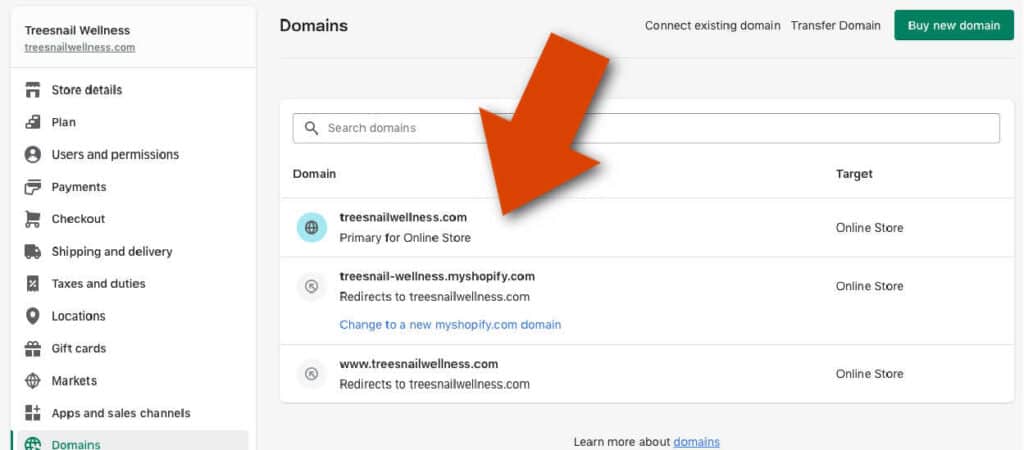
Most sellers choose to use their own domain so that no other future sellers can use that business name, while also making it easy for customers to find you online.
If you already have a domain through a registrar such as GoDaddy, you can easily transfer it to Shopify.
Alternatively, you can purchase a domain name straight through Shopify.
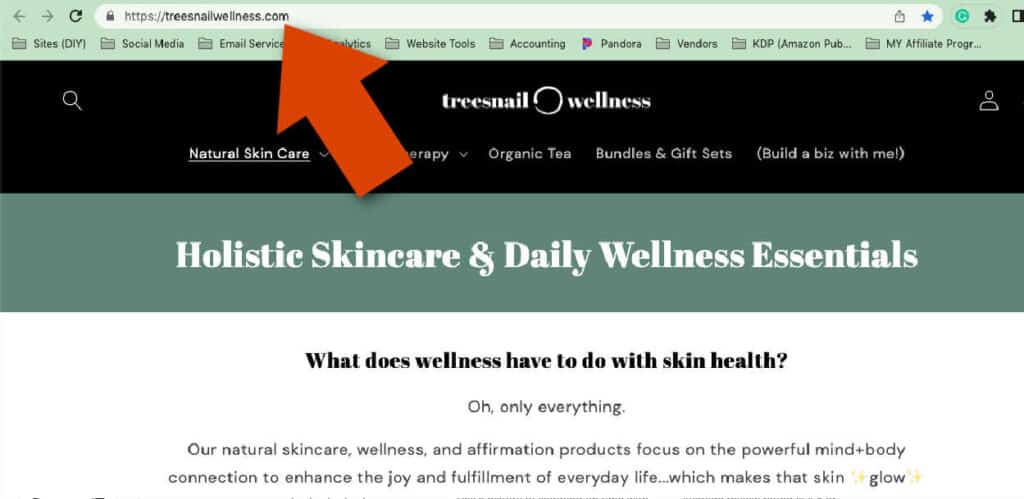
Etsy Domains
On Etsy Standard, there is no way for you to attach your own domain name, even if you own one.
Your Etsy website address will look like this: www.etsy.com/shop/yourshopname
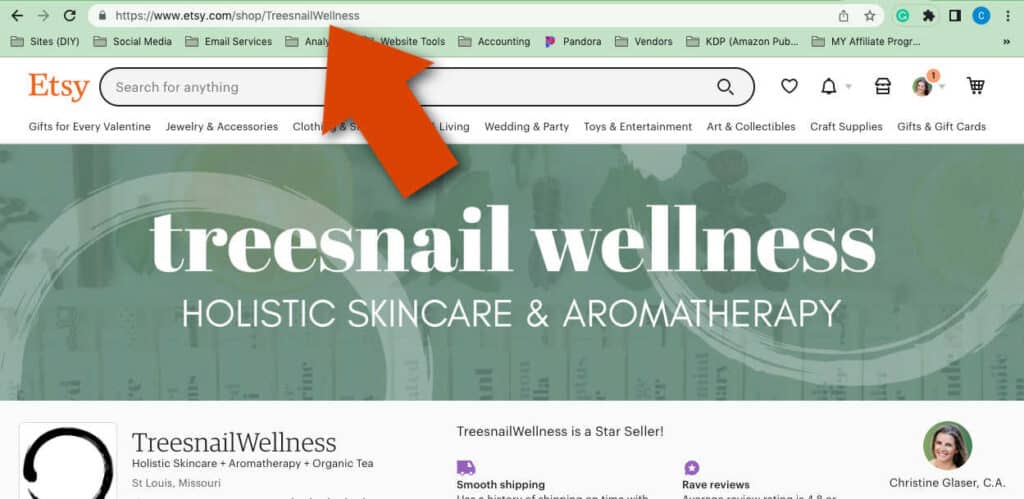
Design and Branding Flexibility
Shopify Customizations
Shopify offers a wide range of options to customize your website according to your unique business branding.
Some people love the number of options, some people get stuck in the details – it all depends on your background experience in design and comfort in navigating new programs.
Shopify Website Themes
A theme is the overall foundation and layout of your site and how it works and responds together. Shopify has tons to choose from, ranging from free to $300 and up.
Looking at the photo below, you can see that I narrowed the possible themes down to just showing the health and beauty industry – there are 4 free and 91 paid options available (you can always view a demo store before choosing):
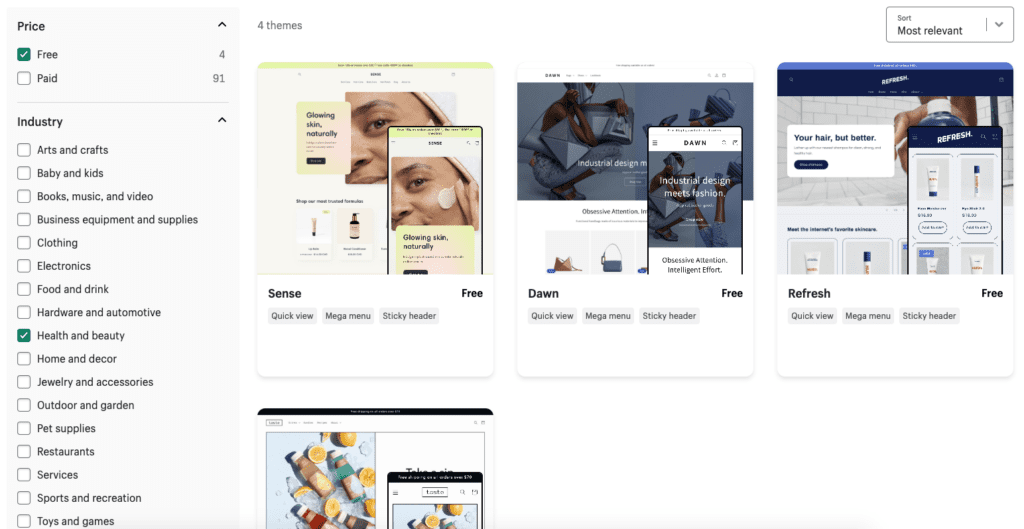
Shopify Theme Settings
You can make tons of changes within each theme as well to suit your branding needs, such as overall color palette, typography, spacing between items, how it transfers over to mobile view, buttons, etc.
As you can see on one of my product pages below, you have a huge range in design freedom and flexibility – everything you see on the product page is editable with the menu on the left side of the screen.
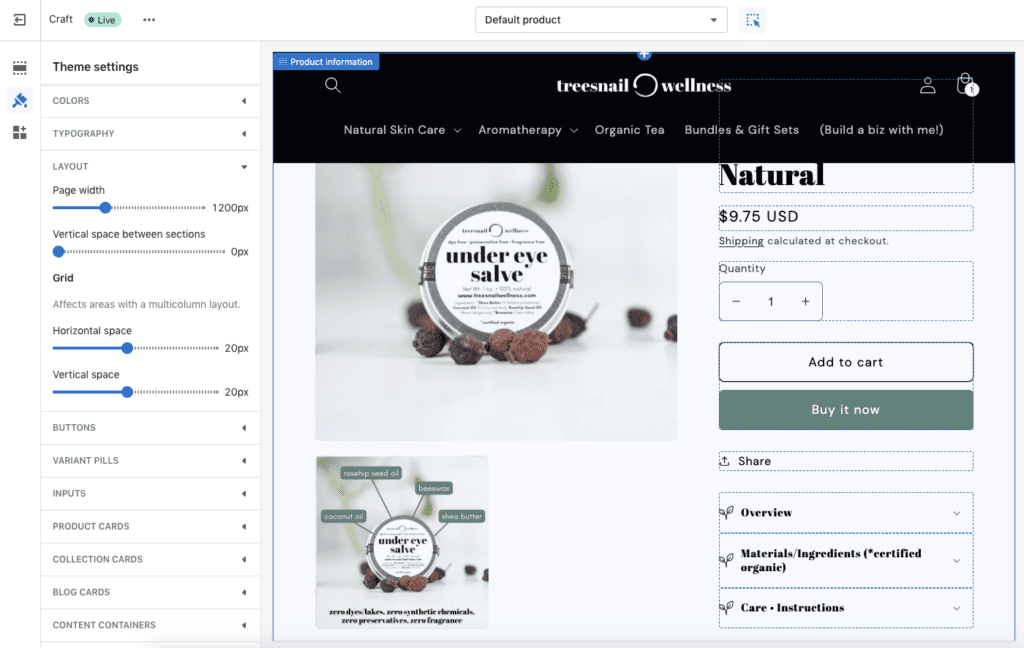
Shopify Design Ease of Use
Any program takes experimentation and time to get used to, and Shopify is no different. I can say that compared to other website builders I have tried (Wix, Squarespace, WordPress, Woocommerce), this Shopify was the easiest for me to learn.
There is no code to work with, and the choices you make about each design element (color palette, font pairings, buttons) apply to the entire website to help you keep a consistent aesthetic.
This means if you change the font on your home page, you’re changing the font on every other page as well. Same with all other design elements.
Shopify Apps
In addition to CHANGING the templates and theme settings, you can also ADD elements to your Shopify site through the App store. There are many free apps available as well as those with monthly or annual charges.
The screenshot I have shared below shows that I currently have 7 different apps installed on my Shopify site for a variety of reasons (a more customizable announcement bar, Instagram feed, reviews, a 3rd party shipping service, etc).
If Shopify ends up being the best online platform for your handmade skincare business, keep in mind that every app you add does slow your site down a little bit, so you’ll want to only install the ones you need to run your business efficiently.
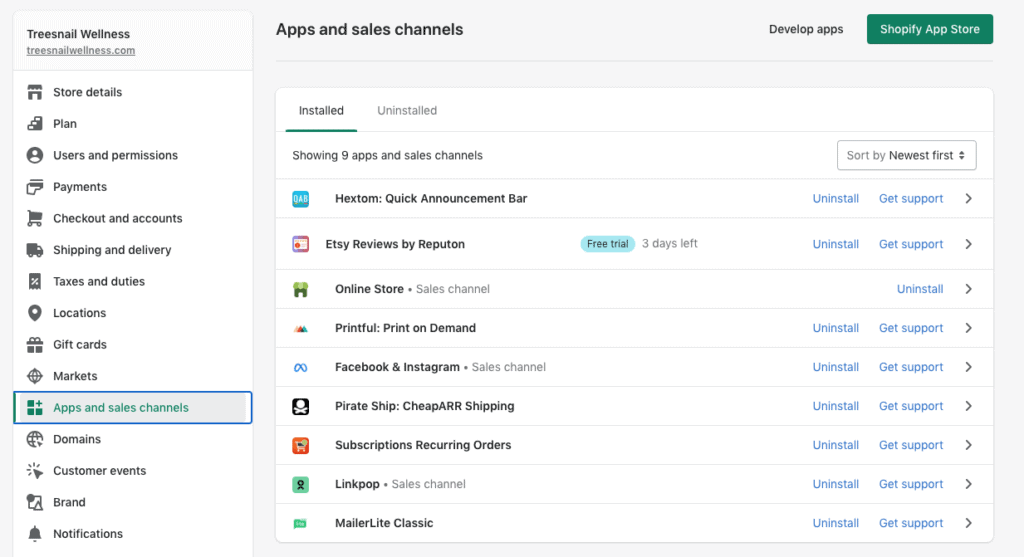
Etsy Customizations
The customizations available on Etsy are far less than on Shopify. For some people, this is great since that means less time in setting up shop; for others, this is a deal breaker since this means a less branded look.
Etsy Banner Styles
The main design element on your Etsy shop page is the banner, and you get to choose how this is displayed: a big banner, a mini banner, or no banner at all (as you can see in the image below, there are other options available with the Etsy Plus upgrade that is not discussed in this post).
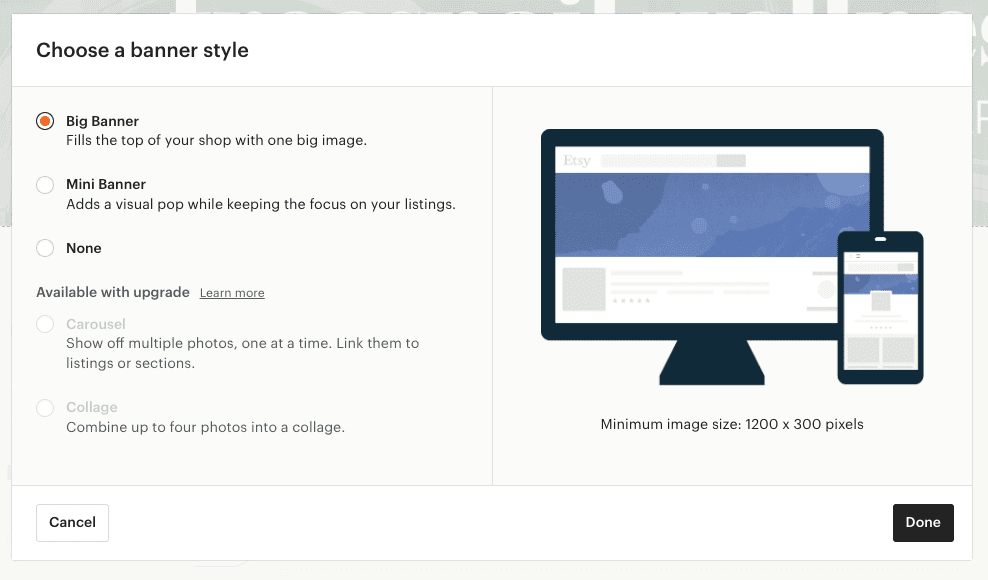
Etsy About Section
You are unable to add extra pages to an Etsy Standard account, but there is an About Section that allows you to add your shop story, a video, and up to 5 images with captions to your home page.
This section isn’t always seen by customers, as it is placed at the very bottom of your shop underneath all listings and reviews. However, don’t ignore this section, as it can be useful for SEO (search engine optimization) purposes.
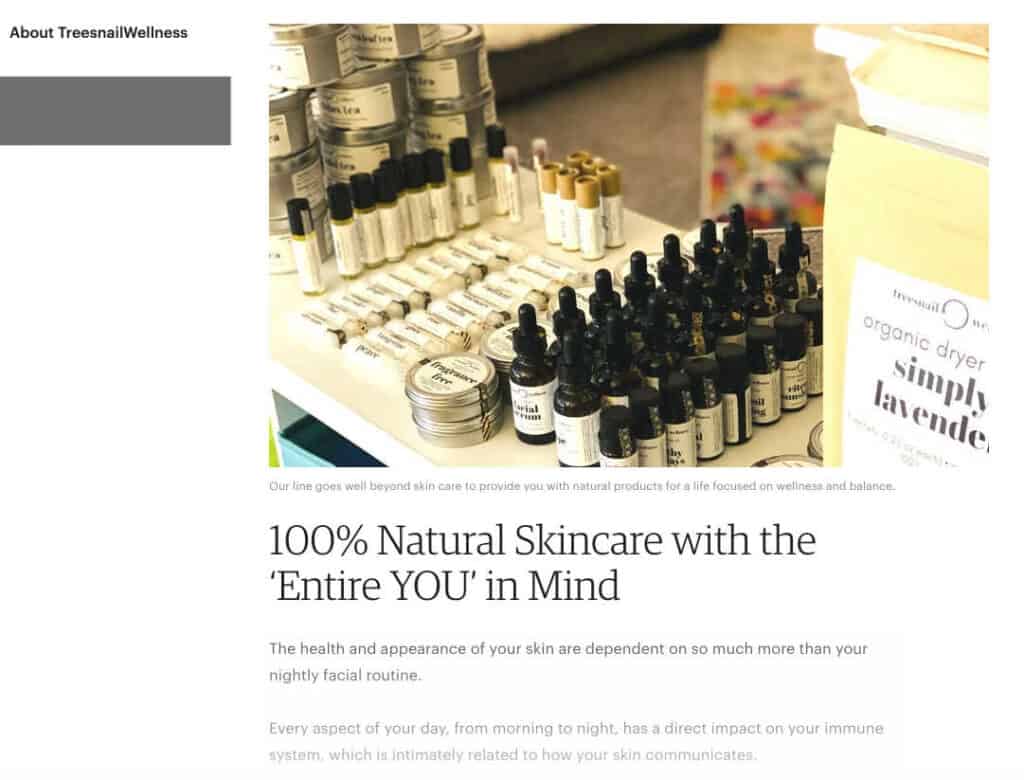
Etsy Design Ease of Use
It doesn’t get more simple than setting up an Etsy shop.
Options such as a website color palette, typography, page spacing, etc. aren’t available for you to change, so there’s not much to do!
If you are already comfortable using a graphic design program (such as Canva) to create your shop banner, you can easily get your shop up and ‘branded’ in a few hours.
Product Maximums
Shopify Products: Unlimited
You can list as many products in Shopify as you want for the same monthly or annual fee based on your plan.
Etsy Products: Unlimited
You can have as many products as you want to be listed in your Etsy shop, but you pay the twenty-cent listing fee for each one (and then again each time is it renewed – either due to a customer sale or automated renewal every 4 months).
As a seller, you’ll have to do the math to see which online platform makes financial sense. Once you have close to 100 products on Etsy (and/or have a high volume of sales and resulting relisting fees), it will be worth your time to break out a calculator to see which is the most economical.
Online Platform Traffic
Shopify Traffic
Straight from the mouths of Shopify sellers themselves, generating traffic is the most difficult aspect of this platform (or any stand-alone website, for that matter).
You have to bring your own traffic to your site through social media marketing, email marketing, ads, SEO tactics, word of mouth, influencers, user-generated content, and anything else you’d like to try.
This can be TONS of fun if you like marketing – but it does take a lot of time.
Etsy Traffic
While you will still need to do your part to generate traffic to your Etsy shop for consistent sales, you do have the benefit of Etsy having a built-in audience.
People come to Etsy with purchasing in mind, so you’ve already battled away half the website noise.
In addition, Etsy does a lot of work on your behalf to advertise shops that have great product photography, stories, and product reviews.
Through Editor’s picks (shopping lists that Etsy employees put together), email roundups based on a customer’s specific search history, blog posts, and working with Google for page one features, you can see why there are some extra fees on Etsy for their advertising efforts.

Customer Service and Communication
Shopify Customer Service
As the website owner on Shopify, you are responsible for having a way for your customers to communicate with you. This means having a professional email address, installing a chatbox app, or other avenues to answer questions and resolve issues.
Shopify Email Marketing
For other communications such as sending out new product launches, sale information or business updates, you will want to use an email service provider.
Email marketing has a higher sales conversion rate than social media and search combined, though it does take more upfront work to get set up.
There is a Shopify email marketing app that is available for free (disclaimer: it does have a mixed bag of reviews); however, I recommend MailerLite when you’re ready to grow in that area instead of what Shopify offers.
Etsy Customer Service
Etsy provides a messaging portal to all sellers in hopes that most of the communication is handled between seller and customer.
Customers can message you directly through this feature with questions about your products (before and/or after the sale), issues with their orders, or special requests.
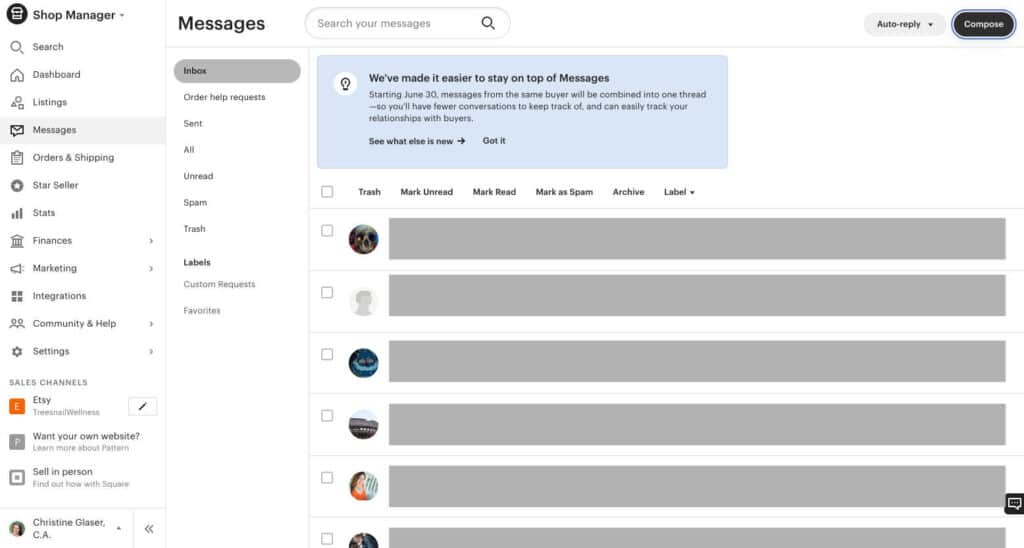
However, because Etsy is a marketplace and not a stand-alone website, customer service situations can get taken out of your hands depending on the situation.
If a customer escalates a problem to Etsy instead of you directly, they have the power to refund the customer – this can result in funds being withdrawn from your account without you knowing ahead of time.
Etsy Email Marketing
Though Etsy does provide you with the messaging portal, it is for questions and issues only – not marketing.
Email marketing is not allowed through Etsy, and if you use the messaging portal in this way, you can get suspended or even have your account shut down.
If you end up deciding that Etsy is the best online platform for your handmade skincare business but ALSO want to send newsletter promos, you will need to provide a separate link connecting to an email service provider such as MailerLite in your product descriptions or as one of your product photos.
Customer Reviews
Shopify Customer Reviews
It is up to you to display customer reviews on your Shopify site.
This is highly recommended, as many people rely on reviews more than reading actual product descriptions these days.
Shopify has many different apps available for this detail, including a variety that imports reviews from your other sales channels. This adds a nice professional touch to any theme:

Etsy Customer Reviews
Etsy requires that all customer reviews be shown on your shop page and individual product listings.
Your overall rating is also shown at the top of your shop and in the bottom section where all of your reviews are listed.
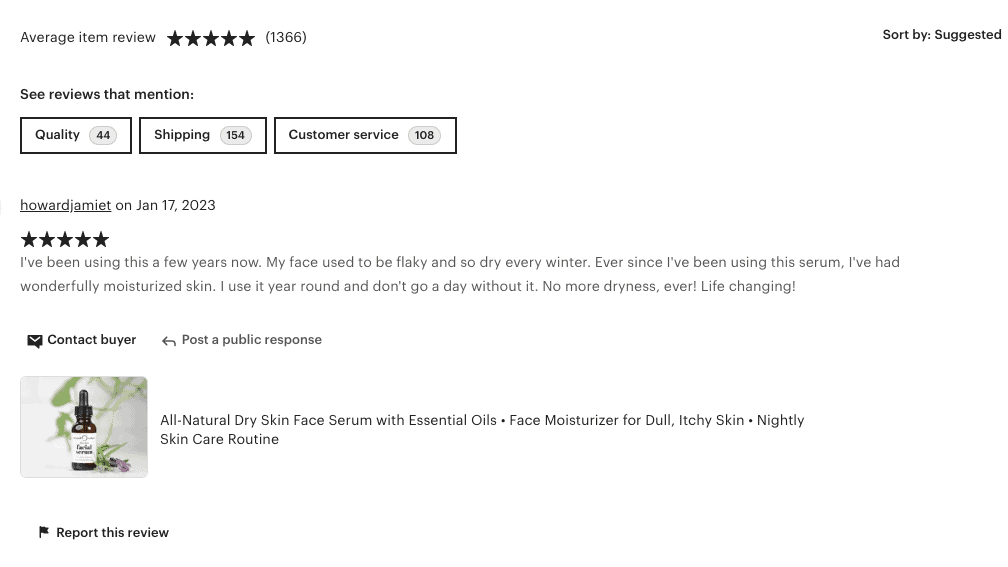
SEO (Search Engine Optimization)
Search engine optimization refers to the process of setting up your website so that it shows up when someone searches for a word or phrase.
Shopify SEO
Aside from social media and email marketing, improving the SEO on your Shopify site is the top way to get customers to see your skincare products.
You can improve your Shopify SEO by using keywords in the following areas:
- Product title
- Product URL
- Product description
- Image alt-text
- Links
- Category pages
- Blog posts
You can also improve your SEO with the following tasks:
- Compressing images
- Minimizing the number of apps you use
- Designing an easy-to-navigate site
- Maximizing the amount of time customers stay on your site
- Encouraging a customer to view several pages of your site
- Receiving backlinks from other highly ranked websites
Etsy SEO
As there is not as much to customize on Etsy, the same is true for SEO possibilities (compared to Shopify).
However, there is still a fair amount you can do to improve your SEO with keyword usage in:
- Product titles
- Product descriptions
- Product tags
- Image alt-text
The Etsy marketing team does a fair amount of work to get shops seen on Google, but understand that they have ALL shops in mind, not just yours.
You can further optimize your shop for seasonal selling (a huge opportunity for Etsy sellers!). Check out the strategies in the Etsy SEO and SSO Guide if you will be using this platform for your handmade skin care business.
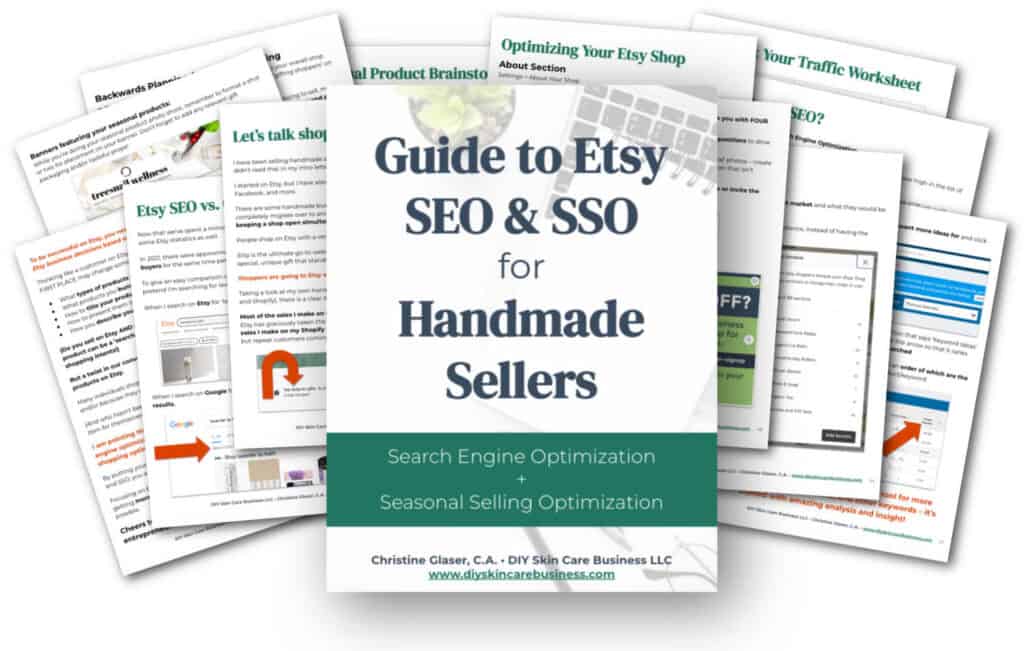
Managing Your Store
Shopify Management
After your Shopify store is set up, you will still need to be in and out of the platform to add new listings, change the pricing for sales, add coupon codes, update inventory, and more.
Shopify makes this easy to do with both a desktop and mobile app version so that you can tend to your store no matter where you are.
There is a customer support team available to help you with any questions, and they are pretty good about getting back to you in 24 hours with a thorough answer.
Etsy Management
Etsy also has both a desktop and mobile app to help you manage the behind-the-scenes details of your shop.
The support team on Etsy isn’t as responsive to inquiries (depending on the issue), but they do have a ton of information available in their handbooks and tutorial pages.
(Note: There are many peer-led Facebook support groups for Etsy sellers, and these resources aren’t always positive.
Because of the low cost of getting started on Etsy, many shops haven’t taken the time to educate themselves about how to turn it into a business…this results in a lot of confusion and cranky-pants comments.
Be wise about which peer-led support groups you join!)
Shopify Roundup
All the points in one list to help you decide if Shopify is the best online platform for your handmade skincare business:
- E-commerce platform: Completely in charge of it all, including products, customer service, taxes, communication, etc.
- You ‘own’ your site and information, including customer information, site reviews, email subscribers, etc.
- Free trial: 3 free days then $1/month for 3 months.
- Monthly or annual subscription costs (3 different plans available).
- Additional transaction fees apply.
- Can choose to use either a Shopify domain name or your own domain name.
- Large amount of customizations available, including website templates, theme settings, and apps.
- Unlimited product listings.
- You have to generate all of your own traffic through social media marketing, email marketing, ads, and/or search engine optimization.
- Email marketing is allowed directly through Shopify.
- You are in charge of your own customer service 100%.
- You are in charge of generating and displaying customer reviews.
- You are in charge of SEO with a great many ways to influence it.
- Desktop and mobile app available for shop management.
Etsy Roundup
All the points in one list to help you decide if Etsy is the best online platform for your handmade skincare business:
- Marketplace platform: One website that hosts many sellers, has its own rules about communication with customers, fees, rules to stay active, and how your shop is seen.
- You ‘rent’ your shop space, which means you are not entitled to customer information, email addresses, and can be ‘evicted’ any time.
- Minimal startup cost at twenty cents per listing.
- No monthly or annual subscription fees.
- Additional transaction fees, conversion fees, Etsy ad fees, off-site ad fees, and payment processing fees apply.
- Must use the Etsy-provided domain name.
- Small amount of customizations available, limited to shop banners and About section.
- Unlimited product listings.
- Etsy helps to generate some traffic for you through email marketing, advertisements, blog posts, and platform-wide search engine optimization.
- Email marketing is not allowed directly through Etsy.
- You have the ability to handle customer issues, though customers have the ability to go straight to Etsy for refunds or cancellations without your approval.
- Etsy requires that all customer reviews are shown on your site.
- Can control some aspects of your own SEO, Etsy does some work on your behalf as well.
- Desktop and mobile app available for shop management.
Can I Start with my Skin Care Business on Etsy and Switch to Shopify Later?
I’ve been in your same exact spot, asking the same exact questions, wondering the same exact things as a handmade skincare entrepreneur.
If you are just starting out on your business journey, I would recommend getting your feet wet with Etsy first. Alleviate the feeling of having to launch an entire product line at once! You can literally just list one item at time, get over that ‘blank canvas’ feeling and take baby steps at a time if you need to.
Etsy is a very approachable platform and will help you get a handle on how long it takes to write product descriptions, do keyword research, develop a brand identity, build a customer base, and a system for fulfilling your orders.
Eventually, it does make financial and professional sense to migrate to Shopify if you are creating a larger product line and having success with sales.
To have the true ability to scale your business, you will want the authority and flexibility that comes along with having your own domain name, email list, and website.
There are many apps available on Shopify that help you to migrate everything over once you are ready so that it’s a more seamless process.
Can I Host my Handmade Skincare Business on BOTH Etsy and Shopify?
Yes, you can absolutely sell on both Etsy and Shopify. I currently do!
This is a great strategy (in my experience) so that you can reap the benefits of the warmer Etsy traffic while using social media and email marketing to generate traffic to your Shopify site.
Best of both worlds!
I would NOT recommend opening both storefronts at the same time, as that would create overwhelm. But something to keep in mind after you get into a rhythm on Etsy.
If you decide to sell on both Etsy and Shopify, you will want to make sure that your product titles and descriptions are different in order to avoid duplicate content for SEO purposes.
In addition, you will need to be confident in your inventory management to keep up with fulfilling orders for two different platforms.
Grow your Handmade Skincare Business with Shopify
If you have chosen Shopify as the best online platform for your handmade skincare business, keep moving right along by signing up with the form below:

Grow Your Handmade Skincare Business with Etsy
If you have chosen Etsy as the best online platform for your handmade skincare business, grab yourself 40 free listings with the form below:
If you have still have questions or would like more opinions about Shopify and Etsy, head over to our private community Facebook group to ask your fellow skincare makers!
Grow Your Skin Care Business!
Browse through the resources below to boost your handmade business visibility and profitability!



